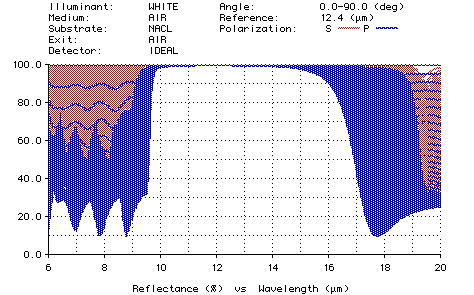Dielectric Omnidirectional Reflector
In a recent paper,
-
Yoel Fink, Joshua N. Winn, Shanhui Fan, Chiping Chen, Jurgen Michel, John D. Joannopoulos,
and Edwin L. Thomas, "A Dielectric Omnidirectional Reflector", Science, Vol 282, 27 Nov 1998,
pp 1679-82.
the authors discuss manufacturing a dielectric reflector that reflects P and S polarized light well for all incident angles for a fairly wide range of wavelengths. Such a reflector has the advantages of a metallic reflector, without the absorption that comes with metals. Their 9-layer reflector is composed of two dielectric materials, low-index (L=1.6) polystyrene and high-index (H=4.6) tellurium. The usual design is (HL)^4 H, with each thickness 1 QWOT at 12.4 microns. However, the layer thicknesses can be varied somewhat to slightly increase the width of the reflectance band. Although the authors deposited their reflector on a NaCl substrate, it should work well on a variety of substrates.
Using optimization, the layer thicknesses can be adjusted to shift and widen the reflectance band. Ten continuous optimization targets were used:
-
R = 100% for 10-15 microns and for angles 0, 10, 20, 30, 40, 50, 60, 70, 80, 89
The (HL)^4 H design was used as the initial design. Optimization adjusted the first 8 layers slightly; the thickness of the 9th layer -- the outermost layer -- was reduced by almost half. The plot below shows the performance of the optimized reflector with all angles 0-90 degrees superimposed. It can be seen that the P and S reflectance is very high (>95%) for all angles and all wavelengths 9.8 to 15.5 microns.

H 691.88
L 2112.33
H 700.83
L 2089.58
H 701.51
L 2097.40
H 696.76
L 2165.33
H 399.00
Commentary: the results of the Fink, et al paper follow from the standard theory of thin films. For commonly used dielectric materials, the index ratio H/L is low, which leads to a narrow wavelength range over which the mirror is an omnidirectional reflector. By using materials with a very high H/L ratio, this wavelength range becomes much wider, as illustrated in Figure 3 of their paper. Some news articles about this paper have called the omnidirectional mirror a "perfect" mirror, i.e., 100% reflector at all angles. This statement is true for only theoretical constructions having an infinite number of layers. Real mirrors of this type approach 100% reflectance, but never attain it.